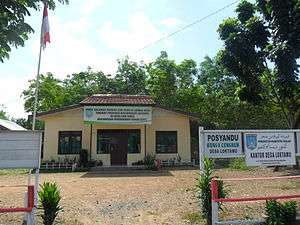Banjar language
| Banjarese | |
|---|---|
|
Bahasa Banjar بهاس بنجر | |
| Native to | Indonesia, Malaysia |
| Region | South Kalimantan (Indonesia), Malaysia |
| Ethnicity | Banjar people |
Native speakers | 3.5 million (2000 census)[1] |
| Language codes | |
| ISO 639-3 |
Either: bjn – Banjar bvu – Bukit Malay |
| Glottolog |
banj1241[2] |
| Linguasphere |
31-MFA-fd |

Banjar (Banjar: Bahasa/Basa Banjar, Indonesian: Bahasa Banjar, Jawi: بهاس بنجر) is an Austronesian language used by the Banjarese people of South Kalimantan, Indonesia. As many Banjarese people are travelling merchants, they brought their language wherever they went all over Indonesia.
Language use
Especially on the island of Kalimantan, Banjarese can be considered as a lingua franca, as it is used widely in three of the five provinces of Kalimantan: South Kalimantan, East Kalimantan, and Central Kalimantan, with the exception of West Kalimantan and North Kalimantan, where proper Malay is more popular.
Relationship to Standard Malay
Although Banjarese is considered to be local Malay,[1] it is not particularly close to other Malayan languages.[3] It is divided into two major dialects; the upper river (Banjar Hulu) and down river (Banjar Kuala) dialects. The main differences of the two dialects can be found in phonology and lexicons, although slight differences in syntactic structure can also be noticed. Banjar Hulu has only three vowels, namely /i/, /u/, and /a/. When a word contains vowels other than these three, the foreign vowel will be replaced with one of them based on the closeness of height and other quality of the vowels.
Pronunciation
For example, Banjarese speaker trying to pronounce the English word "logo" will sound like pronouncing the Indonesian word for innocent, "lugu". The Indonesian word "orang" for human will be pronounced "urang". The word "ke mana" (where) will be pronounced and even many times spelled "ka mana". Other distinctive characteristic of the Banjar Hulu dialect is that words beginning with a vowel are most likely to be pronounced with an /h/ sound in front of the words. The addition of the /h/ sound can also be noticed in the spelling.
Dialects
A minor dialect, Bukit, is assigned a separate ISO code.
See also
- Banjar people
- Banjarese architecture
- Banjarmasin
- Kalimantan Selatan
- Paradisec collection of Banjar recordings from a 2007 language documentation university course
References
- 1 2 Banjar at Ethnologue (18th ed., 2015)
Bukit Malay at Ethnologue (18th ed., 2015) - ↑ Hammarström, Harald; Forkel, Robert; Haspelmath, Martin; Bank, Sebastian, eds. (2016). "Banjar–Bukit Malay". Glottolog 2.7. Jena: Max Planck Institute for the Science of Human History.
- ↑ Austronesian Basic Vocabulary Database
| Banjar edition of Wikipedia, the free encyclopedia |